Doença de Petri da Videira - UTL Repository - Universidade Técnica ...
Doença de Petri da Videira - UTL Repository - Universidade Técnica ...
Doença de Petri da Videira - UTL Repository - Universidade Técnica ...
Create successful ePaper yourself
Turn your PDF publications into a flip-book with our unique Google optimized e-Paper software.
EXTENDED ABSTRACT<br />
Several species of Phaeoacremonium and the species Phaeomoniella chlamydospora are<br />
the causing agents of <strong>Petri</strong> disease in grapevines. These fungi also play an important role<br />
in the esca complex pathology. In recent years, these diseases have been responsible for<br />
sizeable <strong>da</strong>mages and losses in the production of table grapes and wine production.<br />
Therefore, it becomes imperative to advance the knowledge on these diseases, for better<br />
un<strong>de</strong>rstanding of their behavior and possible disease control.<br />
In the present study, the pathogenicity of seven isolates of Pa. chlamydospora was<br />
studied. For one of these isolates, studies were also carried out in the field to assess the<br />
efficiency of new fungici<strong>da</strong>l products. Pathogenicity tests were carried out with all the<br />
seven isolates in potted grapevine plants (in vivo assays) of the cultivar Touriga<br />
Nacional, growing un<strong>de</strong>r greenhouse conditions during four months in or<strong>de</strong>r to register<br />
canker <strong>de</strong>velopment and to perform re-isolations. Two infection methods were tested,<br />
using either mycelial fragments as inoculum (agar plugs) or spore suspensions (from<br />
liquid cultures). Pathogenicity was confirmed for all the isolates of Pa. chlamydospora,<br />
relative to control plants, which were not inoculated. It was possible to re-isolate Pa.<br />
chlamydospora from all inoculated plants, while the percentage of re-isolation for not<br />
inoculated plants was null. Isolate PL 2 produced the longest necroses. The highest<br />
percentages of re-isolation were obtained with isolate T21 L330 when inoculation<br />
occurred with spore suspensions or with isolate T16 L299 when inoculation occurred with<br />
mycelial disks. The best percentage of re-isolation was observed when mycelial disks<br />
were used as inoculum.<br />
The efficacy of six new fungici<strong>de</strong> formulations was tested un<strong>de</strong>r field conditions for the<br />
cultivars Syrah and Touriga Nacional. Results were compared to those obtained from<br />
plants treated with carben<strong>da</strong>zim+flusilazol (Escudo ® ), which was used as a stan<strong>da</strong>rd.<br />
Products were applied once on the pruning wound. For each treatment, 18 replicates (1-<br />
yr-old shoots) were used, which were inoculated with a spore suspension prepared from<br />
250 mL malt extract medium inoculated with 3 mm diameter agar plugs cut from the<br />
edge of colonies growing un<strong>de</strong>r <strong>da</strong>rkness at 20ºC. Liquid cultures were incubated for 14<br />
<strong>da</strong>ys on a reciprocal shaker at 90 rpm, filtrated and then diluted with SDW to a final<br />
concentration of 10 5 spores mL -1 . Inoculation of test plants occurred one <strong>da</strong>y after<br />
fungici<strong>da</strong>l application. Approximately 50 µL of the spore suspension of Pa. chlamydospora<br />
were applied on each pruning wound and the inoculated wounds were protected with<br />
“Parafilm”.<br />
Assessments were performed six months after inoculation by observation of the internal<br />
symptoms, browning tissues or presence of necroses. The length of the shoots, the<br />
IV



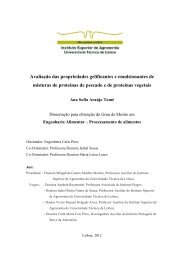
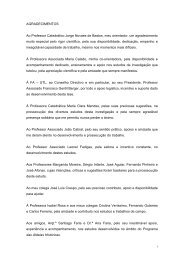

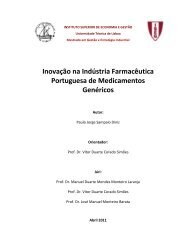
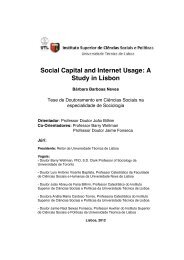
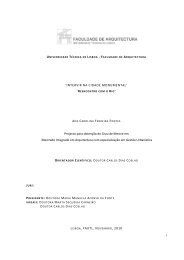
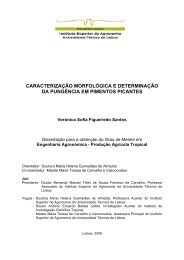

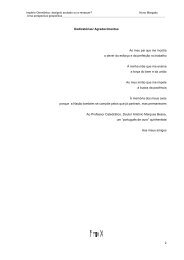
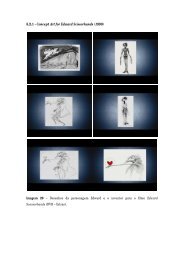
![Tese - Es..[1].pdf - UTL Repository - Universidade Técnica de Lisboa](https://img.yumpu.com/25707135/1/184x260/tese-es1pdf-utl-repository-universidade-taccnica-de-lisboa.jpg?quality=85)


